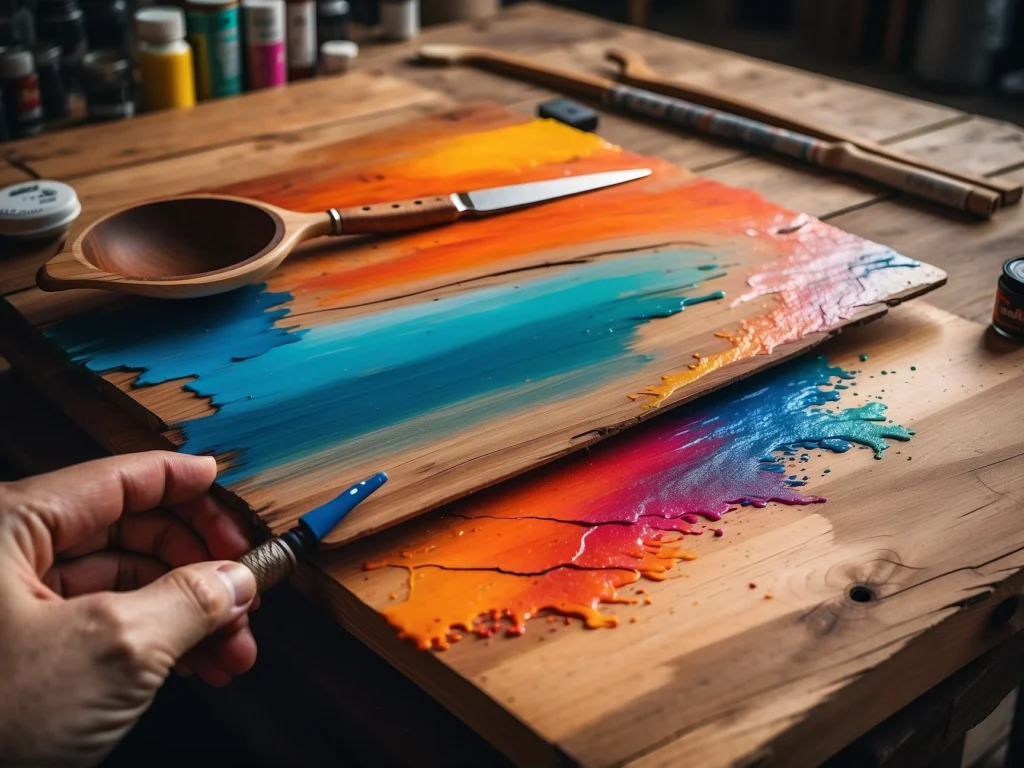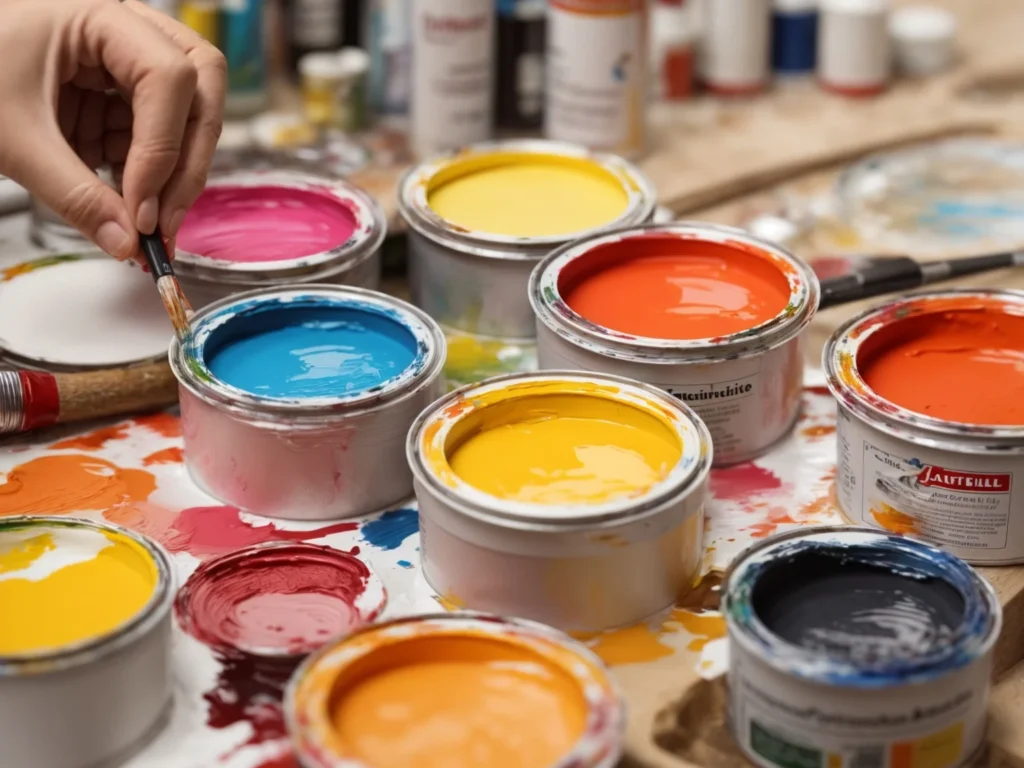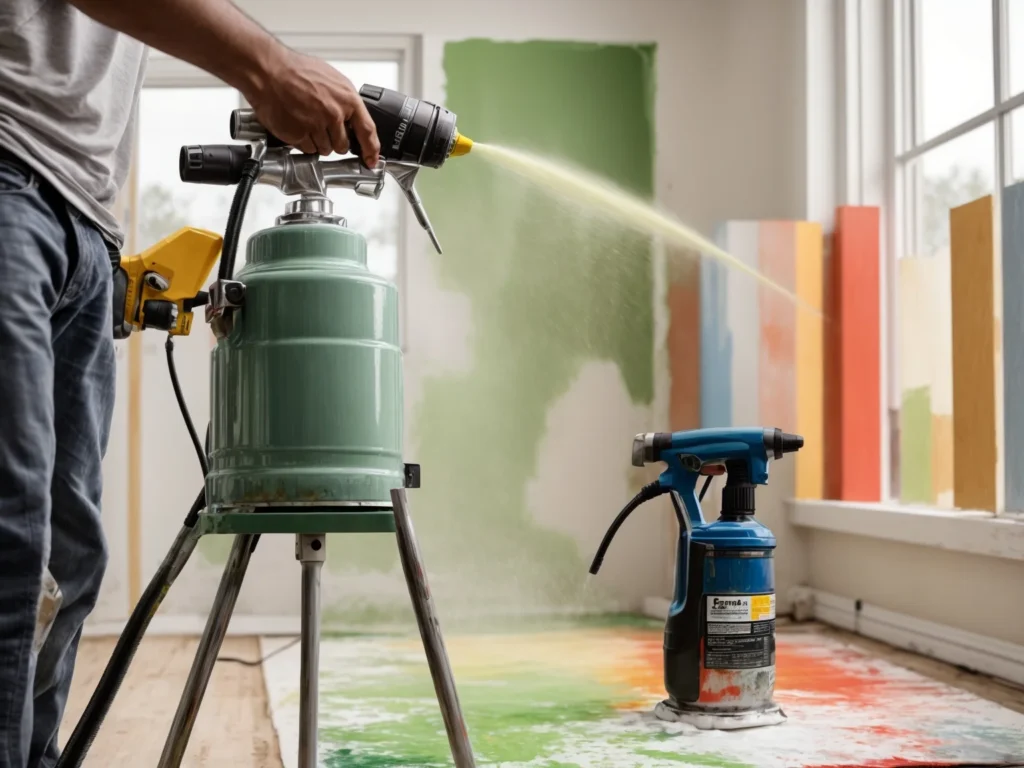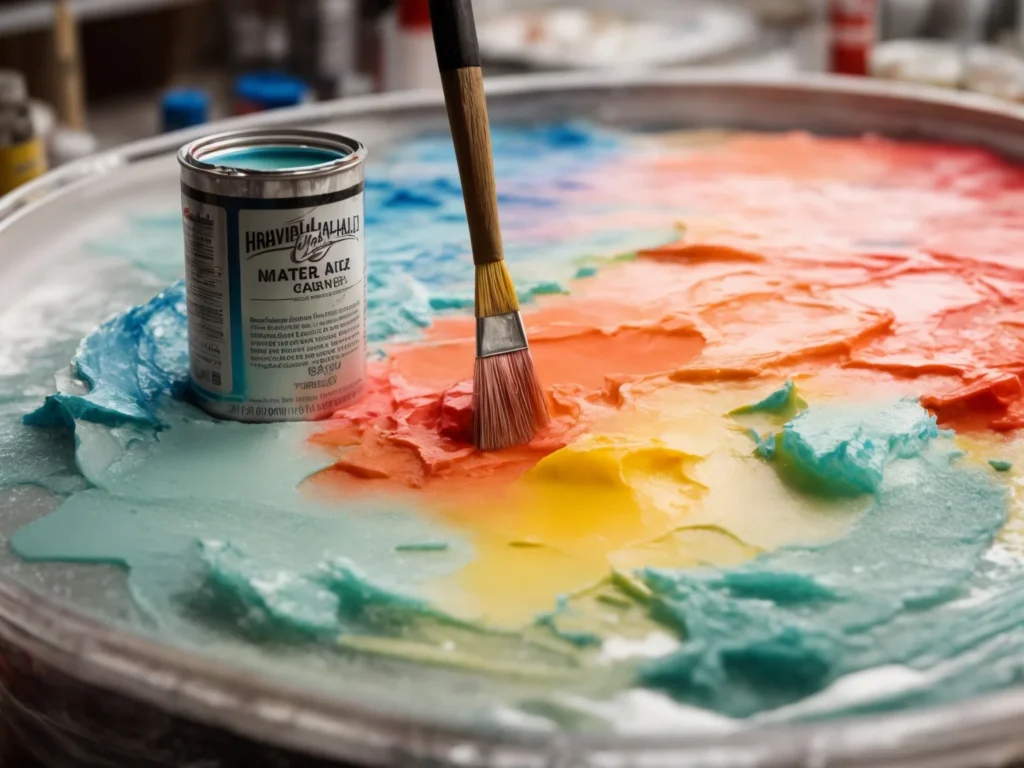Having an outdoor hot tub can be a wonderful way to relax at home. But after exposure to sun, rain, snow, and high temperatures, your hot tub’s cover and exterior cabinet can start to fade, peel and show their age. With simple maintenance and a fresh coat of paint, you can restore your hot tub to look new.

Choosing the Right Paint for Hot Tub Covers
The vinyl covers used on most portable hot tubs can be painted to change or refresh their color. But you can’t use just any paint – you need one specifically formulated for use on plastics. Here are some things to consider when selecting paint for a hot tub cover:
- Acrylic latex paints are recommended for hot tub vinyl covers. Look for paints labeled for outdoor use on plastics, vinyl or marine surfaces.
- Color choice is subjective, but darker earthy tones like brown, tan and forest green are popular since they hide dirt well. Brighter colors will fade faster in the sun.
- A flat finish is best to help hide scratches and imperfections in the vinyl over time.
- Make sure the paint offers UV protection to prevent fading.
- For the most durable and long-lasting results, look for paint designed for flexing/bending surfaces.
- Textured paints can provide extra grip and hide scratches. But they show dirt more easily and are harder to clean.
- 2-part epoxy paint is the most heavy duty option for a super durable and protective finish. But it is more expensive and challenging to apply.
Once you’ve selected an appropriate outdoor vinyl paint, proper preparation and application techniques will ensure it adheres well and provides long-lasting results.
Preparing a Hot Tub Cover for Painting
Here are the key steps for prepping a vinyl hot tub cover before painting:
- Clean the surface thoroughly with a vinyl cleaner to remove dirt, oils and residue. Rinse well and allow to dry fully.
- Lightly sand the surface to improve paint adhesion. A fine grit sandpaper is best for vinyl.
- Wipe clean with a tack cloth after sanding to remove all dust.
- Apply a bonding primer first if recommended by the paint manufacturer.
- Use painter’s tape to mask off any areas you don’t want painted.
Proper prep removes contaminants and gives the paint something to “bite” into. Always refer to the paint’s instructions – some specialized vinyl paints don’t require priming or sanding.
How to Apply Paint to a Hot Tub Cover
Follow these tips for getting the best results when painting your vinyl hot tub cover:
- Work in a well-ventilated area and wear protective equipment like a respirator.
- Use a paint sprayer rather than brushing for a smoother, more consistent finish.
- Apply paint in several thin coats instead of one thick coat, allowing proper drying time between each application.
- Slow, even passes with the paint sprayer prevents drips and runs in the paint.
- Begin and end each pass off the edge of the cover to avoid build up at the seams.
- Rotate around the cover as you paint to reach all angles. Have a helper lift edges if needed.
- Allow the final coat to cure fully before reinstalling the cover, usually around 48 hours.
- Finish with a clear sealer for added protection if desired.
Taking the time to apply several light coats will provide better coverage and a more durable finish than trying to apply too much paint all at once.
How to Revive a Faded Hot Tub Cover
If your hot tub cover has simply faded from sun exposure or chemical damage, you may be able to revitalize it with a fresh coat of vinyl dye rather than paint:
- Clean the cover thoroughly and use fine sandpaper to rough up the surface a bit. This helps the dye adhere and absorb better.
- Choose a vinyl dye in the color you want. Some dyes stand up to chlorine better than others.
- Work the dye into the surface with a soft rag or foam brush using circular motions.
- Let the first coat fully dry, then do a second coat for richer color.
- Once dry, apply 1-2 coats of clear sealer for extra protection.
Re-dyeing can refresh a dulled or faded hot tub cover and extend its useful life a bit longer before needing a full repaint. But severe cracking or damage will require replacing the cover.
Painting Hot Tub Exteriors
The rigid plastic or fiberglass skirting that surrounds a portable hot tub also takes abuse from the elements. Painting the exterior cabinet is the easiest way to restore it to like-new condition.
Cleaning and Prepping the Cabinet
As with the cover, starting with a clean surface is key to proper paint adhesion:
- Use a degreaser and stiff scrub brush to clean off dirt, oils and chemical residue
- Rinse thoroughly and allow to dry fully before attempting to paint
- Lightly sand to improve adhesion, being careful not to damage the finish
- Wipe with a tack cloth to remove any dust
- Apply primer if painting a lighter color over a darker shade
Taking the time to prep and clean means the new paint will stick well and provide longer lasting protection.
Paint Options for Hot Tub Cabinets
There are a couple good options when selecting paint for hot tub exteriors:
- Acrylic latex in a semi-gloss or satin finish works well for plastic or fiberglass. Look for formulations specifically for outdoor use on plastics.
- Epoxy paint is extremely durable and chemical resistant. Two-part epoxy paint kits are made specifically for spa refinishing.
- For wood cabinet panels, use a high quality exterior wood paint for protection.
- Spray cans of plastic paint provide convenience for quick touch ups on plastic or fiberglass.
As with the cover, darker earth tones are popular cabinet color choices. But you can get creative and choose any color you like to match your backyard decor.
Application Tips for Painting Hot Tub Cabinets
These tips will help you get great results painting the exterior:
- Lightly sand between coats for maximum adhesion.
- Spray painting provides a smoother finish than brushing. Hold the spray can 6-12 inches from the surface and apply light, even coats.
- With brushed paint, use a small foam roller for the large flat panels, cutting in edges with a brush.
- Work section by section and allow proper drying time between coats.
- Use painter’s tape to cover any areas you don’t want painted.
- Apply a clear sealer for added protection when finished.
A little patience goes a long way. Adding multiple thin coats will look better than trying to cover in one thick coat.
Painting Fiberglass Hot Tubs
For a built-in or acrylic fiberglass hot tub, repairing chips or refinishing the entire interior surface is a more involved process. Here are the basic steps:
- Clean and lightly sand the gel coat surface
- Apply a two-part epoxy primer to provide an adhesion layer
- Use a two-part polyurethane paint formulated for fiberglass
- Working in sections, apply several thin coats using a foam roller
- Allow proper drying time between coats
- Finish with a clear coat for protection
Fiberglass hot tub paint is available from spa refinishing suppliers. Completely refinishing a large tub takes some work, so consider hiring a professional for best results.
Maintaining and Protecting Hot Tub Finishes
Once you’ve put in the work of painting your hot tub, you’ll want to keep it looking fresh. Here are some simple maintenance tips:
Cover Care
- Replace the cover when not in use to block UV rays which cause fading
- Treat vinyl covers 2-3 times per year with a protectant containing UV inhibitors
- Wash regularly with mild soap and water using a soft scrub brush
- Avoid harsh cleaners which can damage vinyl over time
- Watch for cracks and deterioration as covers wear out and need replacement
Cabinet Maintenance
- Gently wash exterior when needed using a mild cleaner safe for plastics
- Rinse thoroughly after cleaning to remove any chemical residue
- Re-apply paint or clear coat as needed to cover scratches or damage
- Consider removable cabinet panels to make future repairs easier
- Keep cabinets protected from sun and rain by installing a cover lifter for the hot tub
General Upkeep
- Wipe down the tub interior with a soft cloth after each use to prevent chemical buildup
- Use hot tub surface cleaners
- Change out hot tub water every 3-4 months to protect finishes from chemical damage
- Avoid using abrasive brushes or cleaners which can scratch surfaces
- Check any silicone caulk lines around the tub and re-apply as needed to prevent water intrusion
- Keep water chemistry balanced to prevent etching and corrosion
- Consider an ozone generator or mineral sanitizer to reduce chemical usage
- Check filter periodically and replace as needed for clean, clear water
Common Hot Tub Paint Problems and Solutions
Even with proper preparation and application, you may encounter some issues when painting a hot tub. Here are some common problems and how to fix them:
Paint Not Adhering to Surface
If the new paint is bubbling, peeling or flaking off, it means it did not properly adhere to the vinyl or plastic surface underneath. Potential causes include:
- Not properly cleaning and preparing the surface prior to painting
- Applying paint too thickly or in too few coats
- Using the wrong type of paint not specifically formulated for plastics
Solution: Completely remove all loose paint by sanding or stripping. Properly clean, prime and dry the surface, then re-apply the correct type of paint in multiple thinner coats.
Brush Strokes Visible in Paint
Sometimes brushing a paint finish on a hot tub cover or exterior panel can leave unsightly visible brush stroke marks once dry. This happens when the paint is applied too thickly.
Solution: Lightly sand the surface to smooth out the texture, wipe clean, then re-apply new paint in thinner coats using a foam brush or paint sprayer instead.
Paint Fading Over Time
Exterior paints are subjected to harsh UV rays, chemicals and high temperatures which can cause them to fade prematurely if the wrong formulation is used.
Solution: Ensure the paint contains UV blockers and is specifically made for plastics, vinyl or fiberglass. Re-apply fresh coats annually or as needed to keep the color vibrant.
Paint Chalking
Some paint finishes chalk or powder when exposed to sunlight and chemicals over an extended time. This gives the surface a faded, powdery appearance as pigment breaks down.
Solution: Remove chalking layer with light sanding and wipe surface clean. Re-apply paint using a higher quality formulation from a reputable brand to get a more durable finish.
Paint Not Color Matching
Trying to match the existing paint color when touching up hot tub cabinets or making repairs can be tricky. The new paint may dry darker or lighter than expected.
Solution: When possible, use leftover paint from the original application. Otherwise, bring a sample to the paint store for color matching. Spray paints in specific hues for plastics are also available. Test on a small area first before applying the touch-up paint all over.
Hiring a Professional Painter for Your Hot Tub
If your hot tub refinishing project has you in over your head, consider hiring a professional painter familiar with working on plastics and fiberglass. Look for someone with experience with:
- Hot tub vinyl cover repair and re-painting
- Spa resurfacing and re-gelcoating
- Painting plastic or fiberglass hot tub surrounds
- Color matching existing paint for seamless touch ups
- Working with two-part epoxy paints and primers
- Removing old failing paint and properly preparing surfaces
- Spray painting for smooth, consistent coverage
While DIY paint jobs can save money, a professional painter will have the right tools, skills and product knowledge to complete the job properly. Their workmanship can provide longer lasting results. Be sure to get an estimate first and check reviews of their work painting hot tubs.
Transforming Your Hot Tub’s Look
With some simple cleaning, prepping, painting and regular maintenance, you can keep your hot tub looking fresh and vibrant for years of use. Taking the proper steps will result in a durable, long lasting finish that protects from harsh outdoor conditions. And a fresh coat of paint allows you to change up colors and styles when you are ready for an updated backyard look. Just be sure to use the right paint products formulated specifically for hot tub vinyl, plastics and fiberglass to get great results.





